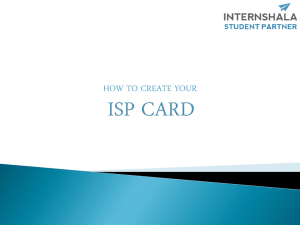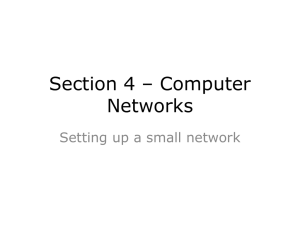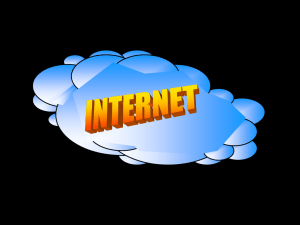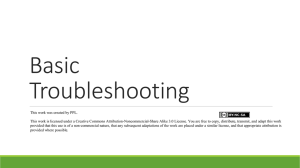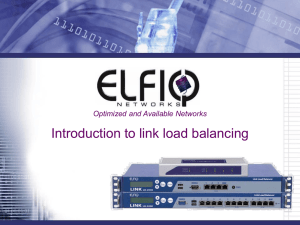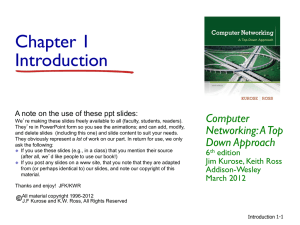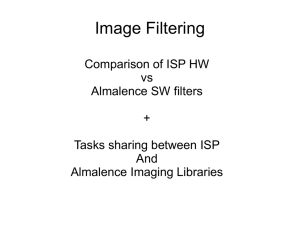Internet Overview - Electrical and Computer Engineering
advertisement
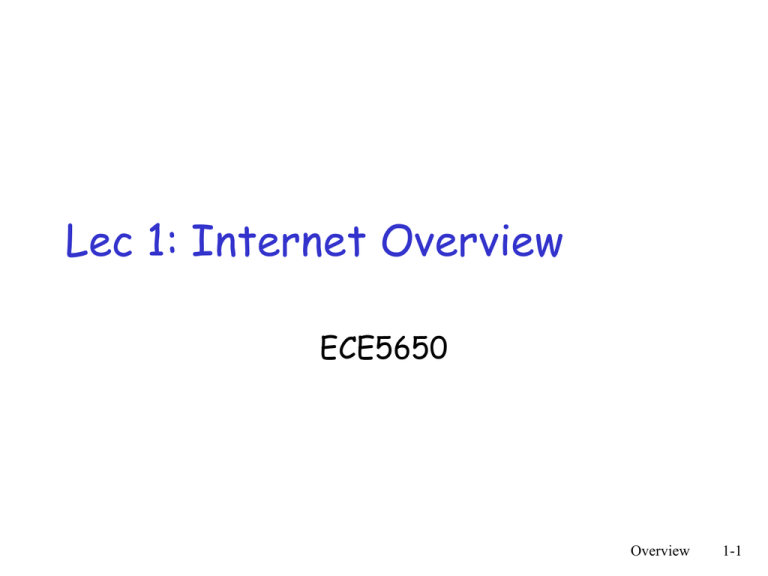
Lec 1: Internet Overview ECE5650 Overview 1-1 Intenet Physical Connectivity Topology Access network and physical media Layered Internet Protocol Stack History Overview 1-2 What’s the Internet: “nuts and bolts” view millions of connected computing devices: hosts = end systems running network apps communication links router server workstation mobile local ISP fiber, copper, radio, satellite transmission rate = regional ISP bandwidth routers: forward packets (chunks of data) company network Overview 1-3 What’s the Internet: a service view Distributed applications: Web, email, games, e-commerce, file sharing Network protocols: used by applications to control sending, receiving of msgs: TCP, IP, HTTP, FTP, PPP Internet standards • RFC: Request for comments • IETF: Internet Engineering Task Force Communication services provided to apps: Connectionless unreliable connection-oriented reliable Overview 1-4 A closer look at network structure: network edge: applications and hosts network core: routers network of networks access networks, physical media: communication links Overview 1-5 The network edge: end systems (hosts): run application programs e.g. Web, email at “edge of network” Programs in end-systems use the serivce of the Internet to send msgs to each other client/server model • client host requests, receives service from always-on server; e.g. web, email peer-peer model: • minimal (or no) use of dedicated servers • e.g. Gnutella, KaZaA, Skype, BitTorrent Overview 1-6 The Network Core Physical connectivity of local area networks mesh of interconnected routers Logical connectivity: how is data transferred through net? Overview 1-7 Internet structure: network of networks roughly hierarchical at center: “tier-1” ISPs or Internet backbone networks (e.g., MCI, Sprint, AT&T, Cable and Wireless), national/international coverage, connect to large tier-2 ISPs and to all tier-1 ISPs and many customer networks. Tier-1 providers interconnect (peer) privately Tier 1 ISP Tier 1 ISP NAP Tier-1 providers also interconnect at public Network Access Points (NAPs). Tier 1 ISP Overview 1-8 Commercial Internet ISP Connectivity Roughly hierarchical Divided into tiers Tier-1 ISPs are also called backbone providers, e.g., AT&T, Sprint, UUNet, Level 3, Qwest, Cable & Wireless An ISP runs (private) Points of Presence (PoP) where its customers and other ISPs connect to it E.g., MCI has 4,500 PoP called private peering ISPs also connect at (public) Network Access Point (NAP) called public peering Overview 1-9 Internet structure: network of networks “Tier-2” ISPs: smaller (often regional) ISPs Connect to one or more tier-1 ISPs, possibly other tier-2 ISPs NAPs (Network Access Points) are complex high-speed switching networks often concentrated at a single building. Operated by 3rd party telecom or Internet backbone ISP-1. PoPs (Points of Presence) are private group of routers within each ISP and used to connect it (peer it) with other up/down/equal ISPs and is the new trend in connectivity. Tier-2 ISPs also peer privately with each other, Tier-2 ISP Tier-2 ISP pays Tier-2 ISP interconnect at tier-1 ISP for public NAPs or connectivity to private POPs. rest of Internet, tier-2 ISP is customer of tier-1 provider Tier 1 ISP Tier 1 ISP Tier-2 ISP NAP Tier 1 ISP Tier-2 ISP Tier-2 ISP Overview 1-10 Internet structure: network of networks “Tier-3” ISPs and local ISPs last hop (“access”) network (closest to end systems) local ISP Local and tier3 ISPs are customers of higher tier ISPs connecting them to rest of Internet Tier 3 ISP Tier-2 ISP local ISP local ISP local ISP Tier-2 ISP Tier 1 ISP Tier 1 ISP Tier-2 ISP local local ISP ISP NAP Tier 1 ISP Tier-2 ISP local ISP Tier-2 ISP local ISP Overview 1-11 Internet structure: network of networks a packet passes through many networks! local ISP Tier 3 ISP Tier-2 ISP local ISP local ISP local ISP Tier-2 ISP Tier 1 ISP Tier 1 ISP Tier-2 ISP local local ISP ISP NAP Tier 1 ISP Tier-2 ISP local ISP Tier-2 ISP local ISP Overview 1-12 Tier-1 ISP: e.g., Sprint Introduction 1-13 ATT Global Backbone IP Network From http://www.business.att.com Overview 1-14 MichNet: Statewide Backbone Nation’s longest- running regional network An 2.5 Gigabit (OC48c) backbone, with 24 backbone nodes Two diverse 2.5 gigabit (2x OC48) to chicago www.merit.edu/mn Overview 1-15 Overview 1-16 Intenet Physical Connectivity Structure Access network and physical media Layered Internet Protocol Stack History Overview 1-17 Access networks and physical media Q: How to connect end systems to edge router? residential access nets institutional access networks (school, company) mobile access networks Keep in mind: bandwidth (bits per second) of access network? shared or dedicated? Overview 1-18 Residential access: point to point access Dialup via modem Uses existing telephony infrastructure; Home is connected to central office up to 56Kbps direct access to router (often less) Can’t surf and phone at same time: can’t be “always on”central office home PC home dial-up modem telephone network Internet ISP modem (e.g., AOL) Overview 1-19 ADSL: asymmetric digital subscriber line up to 1 Mbps upstream (today typically < 256 kbps) up to 8 Mbps downstream (today typically < 1 Mbps) FDM: 50 kHz - 1 MHz for downstream 4 kHz - 50 kHz for upstream 0 kHz - 4 kHz for ordinary telephone Existing phone line: 0-4KHz phone; 4-50KHz upstream data; 50KHz-1MHz downstream data home phone Internet DSLAM telephone network splitter DSL modem home PC central office Overview 1-20 Residential access: cable modems HFC: hybrid fiber coax asymmetric: up to 30Mbps downstream, 2 Mbps upstream network of cable and fiber attaches homes to ISP router homes share access to router so communication activity is visible to each other. deployment: available via cable TV companies Overview 1-21 Residential access: cable modems Diagram: http://www.cabledatacomnews.com/cmic/diagram.html Overview 1-22 Cable Network Architecture: Overview Typically 500 to 5,000 homes cable headend cable distribution network (simplified) home Overview 1-23 Cable Network Architecture: Overview cable headend cable distribution network (simplified) home Overview 1-24 Cable Network Architecture: Overview server(s) cable headend cable distribution network home Overview 1-25 Cable Network Architecture: Overview FDM: V I D E O V I D E O V I D E O V I D E O V I D E O V I D E O D A T A D A T A C O N T R O L 1 2 3 4 5 6 7 8 9 Channels cable headend cable distribution network home Overview 1-26 Company access: local area networks company/univ local area network (LAN) connects end system to edge router Ethernet: shared or dedicated link connects end system and router 10 Mbs, 100Mbps, Gigabit Ethernet LANs: chapter 5 Overview 1-27 Wireless access networks shared wireless access network connects end system to router via base station aka “access point” wireless LANs: 802.11a/b/g (WiFi): 11 Mbps ~54Mbps 802.11n: 100~200Mbps (theoretically up to 300Mbps) wider-area wireless access provided by telco operator 3G ~ 384 kbps • Will it happen?? WAP/GPRS in Europe WiMAX router base station mobile hosts ~100Mbps ~10 miles Overview 1-28 Home networks Typical home network components: DSL or cable modem router/firewall/NAT Ethernet wireless access point to/from cable headend cable modem router/ firewall Ethernet wireless laptops wireless access point Introduction 1-29 Physical Media Bit: propagates between transmitter/rcvr pairs physical link: what lies between transmitter & receiver guided media: signals propagate in solid media: copper, fiber, coax Twisted Pair (TP) two insulated copper wires Category 3: traditional phone wires, 10 Mbps Ethernet Category 5: 100Mbps Ethernet unguided media: signals propagate freely, e.g., radio Introduction 1-30 Physical Media: coax, fiber Coaxial cable: Fiber optic cable: conductors bidirectional baseband: pulses, each pulse a bit high-speed operation: two concentric copper single channel on cable legacy Ethernet broadband: multiple channels on cable HFC glass fiber carrying light high-speed point-to-point transmission (e.g., 10’s100’s Gps) low error rate: repeaters spaced far apart ; immune to electromagnetic noise Introduction 1-31 Physical media: radio signal carried in electromagnetic spectrum no physical “wire” bidirectional propagation environment effects: reflection obstruction by objects interference Radio link types: terrestrial microwave e.g. up to 45 Mbps channels LAN (e.g., Wifi) 11Mbps, 54 Mbps wide-area (e.g., cellular) 3G cellular: ~ 1 Mbps satellite Kbps to 45Mbps channel (or multiple smaller channels) 270 msec end-end delay geosynchronous versus low altitude Introduction 1-32 Intenet Physical Connectivity Topology Access network and physical media Layered Internet Protocol Stack History Overview 1-33 What’s a protocol? human protocols: “what’s the time?” “I have a question” introductions network protocols: machines rather than humans all communication activity in Internet governed by protocols A protocol is a set of rules that govens how two or more communicating parties are to interact. It defines: - msg format - order of msgs sent & received - actions taken on msg transmission & receipt Overview 1-34 Protocol “Layers” Networks are complex! many “pieces”: hosts routers links of various media applications protocols hardware, software Layered Protocol Modular approach to network functionality Examples: • Taking an airplane trip • Mailing service Overview 1-35 Internet protocol stack application: supporting network applications FTP, SMTP, HTTP transport: process-process data transfer TCP, UDP network: host-host data transfer IP link: data transfer between neighboring network elements application transport network link physical PPP, Ethernet physical: bits “on the wire” Overview 1-36 source message segment Ht datagram Hn Ht frame Hl Hn Ht M M M M Encapsulation application transport network link physical Hl Hn Ht M link physical Hl Hn Ht M switch destination M Ht M Hn Ht Hl Hn Ht M M application transport network link physical Hn Ht Hl Hn Ht M M network link physical Hn Ht Hl Hn Ht M M router Overview 1-37 Characteristics of Layering Layering positives: Each layer relies on services from layer below and exports services to layer above Interface defines interaction Hides implementation - layers can change without disturbing other layers (black box) Layering negatives: duplicate functionality and inter-dependency. Overview 1-38 Internet History 1961-1972: Early packet-switching principles 1961: Kleinrock - queueing theory shows effectiveness of packetswitching 1964: Baran - packetswitching in military nets 1967: ARPAnet conceived by Advanced Research Projects Agency 1969: first ARPAnet node operational 1972: ARPAnet demonstrated publicly NCP (Network Control Protocol) first hosthost protocol first e-mail program ARPAnet has 15 nodes Overview 1-39 Initial ARPANET 1965-1968 ARPANET plan, implemented by BBN (Bolt, Beranek, Newman): packet switch to build IMP 1969 ARPANET commissioned: 4 nodes, 50kbps Overview 1-40 Initial Expansion of the ARPANET Dec. 1969 July 1970 Apr. 1972 Mar. 1971 Sept. 1972 Overview RFC 527: ARPAWOCKY; RFC 602: The Stockings Were Hung by the Chimney with Care 1-41 Internet History 1972-1980: Internetworking, new and proprietary nets 1970: ALOHAnet satellite network in Hawaii 1973: Metcalfe’s PhD thesis proposes Ethernet 1974: Cerf and Kahn – archi. for interconnecting networks Initially, named NCP Later, split to TCP/IP late70’s: proprietary architectures: DECnet, SNA, XNA late 70’s: switching fixed length packets (ATM precursor) 1979: ARPAnet has 200 nodes Cerf and Kahn’s internetworking principles: minimalism, autonomy - no internal changes required to interconnect networks best effort service model stateless routers decentralized control define today’s Internet architecture 2005 ACM Turing Award “A protocol for packet network interconnection”, IEEE Trans. on Communications Technology, vol.22(5), 627-641 Overview 1-42 Internet History 1980-1990: new protocols, a proliferation of networks 1983: deployment of TCP/IP 1982: SMTP e-mail protocol defined 1983: DNS defined for name-to-IPaddress translation 1985: FTP protocol defined 1988: TCP congestion control new national networks: Csnet, BITnet, NSFnet, Minitel 100,000 hosts connected to confederation of networks Overview 1-43 Internet History 1990, 2000’s: commercialization, the Web, new apps Early 1990’s: ARPAnet decommissioned 1991: NSF lifts restrictions on commercial use of NSFnet (decommissioned, 1995) Late 1990’s – 2000’s: more killer apps: instant messaging, peer2peer file sharing (e.g., BitTorrent, YouTube) 1992, 1 million hosts network security to early 1990s: Web forefront hypertext [Bush 1945, Nelson Today: 1960’s] 400 million users, 150 countries HTML, HTTP: Berners-Lee backbone links running at 10 1994: Mosaic, later Netscape Gbps late 1990’s: commercialization of the Web Overview 1-44 Growth of the Internet Number of Hosts on the Internet: Aug. 1981 213 Oct. 1984 1,024 Dec. 1987 28,174 Oct. 1990 313,000 Jul. 1993 1,776,000 Jul. 1996 19,540,000 Jul. 1999 56,218,000 Jul. 2004 285,139,000 Jan. 2005 317,646,000 Jul. 2005 353,284,000 About 2B users out of 6.8B people, from 16M in 1995, 350M in 2000,1B in 2005 Overview 1-45 Summary Physical Connectivity Topology Access network and physical media Layered Internet Protocols History Overview 1-46
